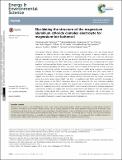Elucidating the structure of the magnesium aluminum chloride complex electrolyte for magnesium-ion batteries
Author(s)
Canepa, Pieremanuele; Jayaraman, Saivenkataraman; Cheng, Lei; Rajput, Nav Nidhi; Curtiss, Larry A.; Persson, Kristin A.; Ceder, Gerbrand; Richards, William Davidson; Gopalakrishnan, Sai Gautam; ... Show more Show less
DownloadElucidating the structure.pdf (3.017Mb)
PUBLISHER_CC
Publisher with Creative Commons License
Creative Commons Attribution
Terms of use
Metadata
Show full item recordAbstract
Non-aqueous Mg-ion batteries offer a promising way to overcome safety, costs, and energy density limitations of state-of-the-art Li-ion battery technology. We present a rigorous analysis of the magnesium aluminum chloride complex (MACC) in tetrahydrofuran (THF), one of the few electrolytes that can reversibly plate and strip Mg. We use ab initio calculations and classical molecular dynamics simulations to interrogate the MACC electrolyte composition with the goal of addressing two urgent questions that have puzzled battery researchers: (i) the functional species of the electrolyte, and (ii) the complex equilibria regulating the MACC speciation after prolonged electrochemical cycling, a process termed as conditioning, and after prolonged inactivity, a process called aging. A general computational strategy to untangle the complex structure of electrolytes, ionic liquids and other liquid media is presented. The analysis of formation energies and grand-potential phase diagrams of Mg–Al–Cl–THF suggests that the MACC electrolyte bears a simple chemical structure with few simple constituents, namely the electro-active species MgCl[superscript +] and AlCl[− over 4] in equilibrium with MgCl[subscript 2] and AlCl[subscript 3]. Knowledge of the stable species of the MACC electrolyte allows us to determine the most important equilibria occurring during electrochemical cycling. We observe that Al deposition is always preferred to Mg deposition, explaining why freshly synthesized MACC cannot operate and needs to undergo preparatory conditioning. Similarly, we suggest that aluminum displacement and depletion from the solution upon electrolyte resting (along with continuous MgCl[subscript 2] regeneration) represents one of the causes of electrolyte aging. Finally, we compute the NMR shifts from shielding tensors of selected molecules and ions providing fingerprints to guide future experimental investigations.
Date issued
2015-10Department
Massachusetts Institute of Technology. Department of Materials Science and EngineeringJournal
Energy & Environmental Science
Publisher
Royal Society of Chemistry
Citation
Canepa, Pieremanuele, Saivenkataraman Jayaraman, Lei Cheng, Nav Nidhi Rajput, William D. Richards, Gopalakrishnan Sai Gautam, Larry A. Curtiss, Kristin A. Persson, and Gerbrand Ceder. “Elucidating the Structure of the Magnesium Aluminum Chloride Complex Electrolyte for Magnesium-Ion Batteries.” Energy Environ. Sci. 8, no. 12 (2015): 3718–3730. © 2015 Royal Society of Chemistry
Version: Final published version
ISSN
1754-5692
1754-5706